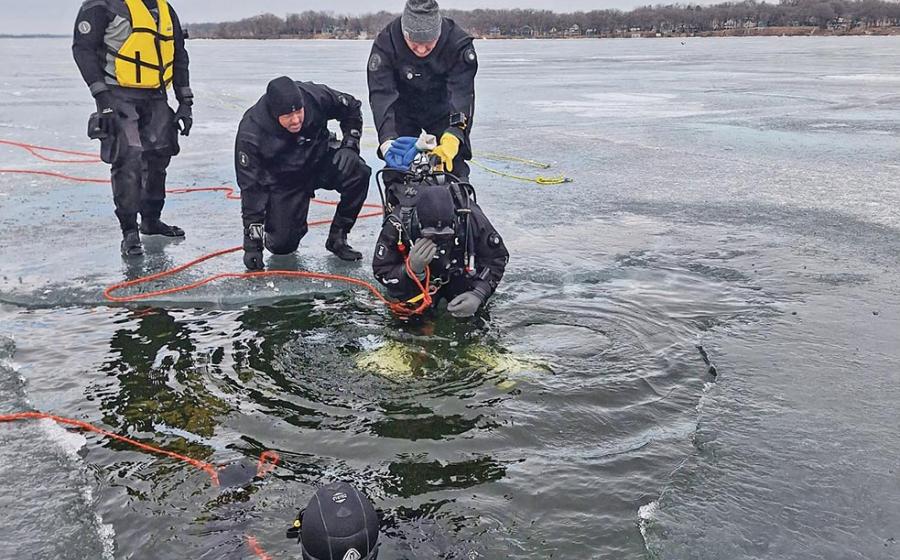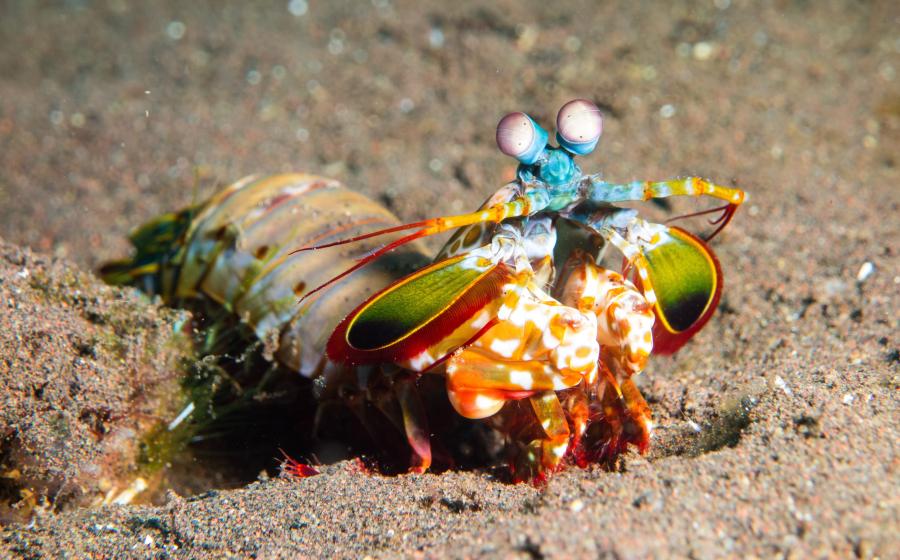Why Tioman Island Is the Perfect Dive Detour

Brandon ColeDivers and chromis damselfish orbit around a multi-peaked mountain of giant barrel sponges in light current at Tiger Rock.
Had a friend not mentioned it, we would have flown right over Tioman Island, ignorant of its many charms. Impressive corals, he said. Colorful fishes, turtles galore and warm, warm water, he added. Relaxing, and rewarding for photography. Not to mention alfresco beachfront dining on the cheap—and tasty. I was sold. I rejiggered our original Borneo-only itinerary, adding Tioman to experience this previously unknown (at least to me) Malaysian gem sparkling in the South China Sea. The result: Best diving detour in years.

Brandon ColeLabas Island from the air.
Diving ABCs
Twenty miles off mainland Malaysia’s east coast, Tioman Island is covered in verdant rainforest and ringed by dreamy beaches, a tropical idyll once ranked among our planet’s most beautiful islands. Scenes from the 1958 Hollywood blockbuster South Pacific were filmed here.

Brandon ColeBigeye snapper school at the Pacman dive site.
Tioman’s theater of scuba—its main diving hub—is Air Batang village (nicknamed ABC). To reach ABC, most people travel overland from international gateway cities Kuala Lumpur or Singapore and then take a two-hour ferry boat ride from Mersing or Tanjung Gemuk to Air Batang.
Related Reading: Embracing the Deep in Chuuk Lagoon

Brandon ColeFrom Left: A close-up look at the eye of a crocodilefish; Tioman Dive Resort and B&J Diving Centre offer great accommodations and diving in ABC Bay.
The majority of Tioman’s dive sites are along the island’s western and northern shores and surrounding offshore islands such as Labas, Chebeh and Coral (Tulai). Numerous dive operators offer daily morning and afternoon charters on boats carrying from four to over 20 guests. Tioman is very popular with the newly certified but also delivers excellent diving for more experienced divers, photographers and videographers around its offshore islands. The cost of a Tioman diving holiday is surprisingly, refreshingly low.

Brandon ColeA crinoid clings to a beautiful harp coral among sea whips on an offshore reef in 75 feet of water.
Biological Profile
Tioman Island’s marine life résumé is built on healthy reefs mostly dominated by hard corals. The staghorn fields around Renggis make for a blissful, laid-back afternoon splash. And the mounds of potato corals, pressed polyp to polyp with artfully whorled lettuce corals and tangled thickets of sundry branching species, are breathtaking at Batu Malang.
Not to be completely outshined, soft corals—sea fans, whip corals resembling shepherd’s crooks, and bushy gorgonians—make good showings at Fan Canyon and Golden Reef. Hawksbill sea turtles are a sure bet for their camera-wielding fans. Fish-watching is fun and productive thanks to angels, spadefish, trevallies, wrasses, fusiliers, puffers, barracudas and more. Bluespotted rays and blacktip reef sharks check the elasmobranch box.

Brandon ColeHuge granite boulders stacked pell-mell create stunning swim-throughs and caverns.
Rocks and Relaxation
Huge granite boulders above the waterline mirror the dramatic terrain below in the waters surrounding Tioman. Chebeh South and Labas South both showcase spectacular underwater architecture begging to be explored. Glide through towering archways, squeeze under the eaves of rocks big as houses and disappear into shadowy inner spaces where clouds of coppery cardinalfish lair.
The K/M Sipadan and a handful of other sunken ships promise metallic structure for wreck aficionados. And Tioman Island’s très casual après-dive scene adds some chill to your scuba holiday. We easily slipped into the alluring island rhythm, kicking back beachside while planning our next day’s dives over spicy Malay kampung eats and spirited libations as the sun melted into the sea.
Related Reading: An Adventurer's Guide to Diving Malaysia’s Perhentian Islands

Brandon ColeA Clark’s anemonefish in its tentacled kingdom.
Better Late Than Never
Nestled in the western corner of the celebrated Coral Triangle, Tioman Island is, unsurprisingly, a haven for tropical marine life. Scientists have recorded hundreds of fish species and thousands of invertebrates. Some of its coral reefs are over 6,000 years old.
The nearshore waters circling Tioman have been protected as a marine park since 1985, with no fishing allowed. Dive boats must use moorings or drift live; anchoring is prohibited. Tourism is the island’s main industry and growing steadily, so conservation of the fragile marine ecosystem and careful management of terrestrial development is essential to ensure a sustainable future for the environment, wildlife and local people’s ways of life.

Brandon ColeA giant moray peers through a coral window.
With its healthy reefs, high biodiversity, great dive culture and compelling value as a scuba destination, it remains a mystery why I had not heard of Tioman Island years ago. Better late than never, and one of the best dive detours ever!
Need to Know
When to Go
Tioman is hot and humid year-round. Serious divers should visit March to November. Monsoon season (December to February) dumps lots of rain, and stormy weather limits diving at the outer islands.
Dive Conditions
Water temperatures range from 80 to 86 degrees. March to May and September to November are best for visibility. Offshore islands have the clearest water (40 to 100 feet), while coastal sites average 20 to 60 feet. Diving depths range from super shallow to beyond recreational. The author’s diving was mostly 30 to 80 feet deep. Currents can be moderate to strong around offshore islands but are usually not an issue elsewhere.
Operator
B&J Diving Centre (divetioman.com) is a PADI Five Star IDC.
Travel Trips
- Bring a rolling duffel to move gear between hotel and dive center.
- Get Malaysian ringgit (MYR) currency from an airport ATM and bring small bills to Tioman for meals.
- Ask your dive operator to match you with people of similar skill level and interests.










